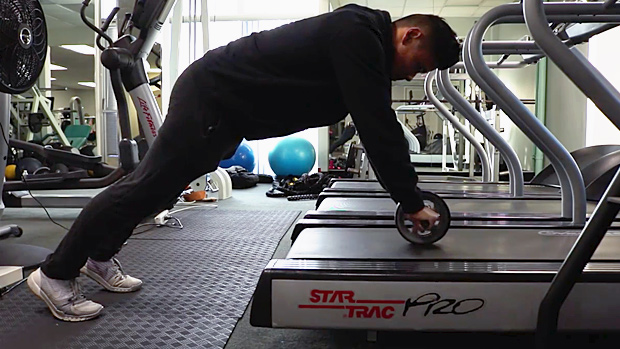Few people do split squats, mainly because they're hard as hell and nobody brags about split squat PRs. But they offer serious training benefits to those brave enough to put their ego aside and take on the challenge.
Lunge Vs. Split Squat: What's the Difference?
This is important. During lunges, your feet are in motion. Whether you're doing the walking lunge, stepping backward for a reverse lunge, or traveling sideways for a lateral lunge, your feet are moving. In practical terms, if you lunge at someone you don't just go up and down. You step toward them... possibly with a fist to the face.
During split squats, your feet stay in place. Kind of the way they do during – yep, you guessed it – a squat. Rather than stepping anywhere, you simply go up and down in the "lunge" or split squat stance.

Although split squats sound simple, doing them is a completely different story. The reason the split squat is so beneficial – particularly the rear-foot elevated split squat or "Bulgarian" split squat – is because of its ability to improve performance and prevent injury.
Why Do Split Squats?
Minimal Stress on the Spine
You don't need to load a barbell behind your neck to get stronger. There are plenty of split squat variations that allow you to progressively overload your lower body without putting your back at risk.
Loading Potential
The ceiling of loading potential (how much weight you can add) is pretty damn high. And you can bypass injured or weak areas, unlike squats. Many lifters are unable to load up their squats due to their lower or upper backs not having the strength to hold it. With many split squat variations, you can increase load solely to your legs while minimizing back involvement.
Enhanced Athletic Performance
Most athletic action is done on one leg: running, walking, skating, jumping, kicking. So it makes sense to train that way. Many athletes would benefit from building single-leg strength since there's a direct carryover to their sport. It may improve your ability to cover more ground per stride due to the increased force production. The more force you can apply to the ground, the more distance you'll cover per stride. This makes you faster.
Hip Extension
The rear-foot elevated split squat involves extension in the rear hip, which is a lost feature in most lifters' training. Many limit their lower body training to leg press, leg extension, and leg curl variations. Rear-foot elevated split squats increase your strength and size and keep you mobile by getting you into an extended position of the rear hip.
Six Split Squat Variations
1. Explosive Landmine Split Squat
Speed and power is the name of the game here. Louie Simmons has said you can't move heavy weight slowly. The faster you attempt to move the bar, the more motor units you engage in the lift. This leads to increased strength and hypertrophy potential. The more muscles you can "wake up," the higher your chances of adding size and strength go.
2. Trap Bar Split Squat
I'm surprised there aren't more people doing this variation because it seems like such an obvious choice. I mean, yes, it looks badass, but the amount of weight you can load here is far above any dumbbells you're going to use.
3. Front and Rear-Foot Elevated Split Squat
Increased range of motion always leads to increased time under tension, which is a plus from a hypertrophy standpoint.
4. Explosive Split Squat with Stride
This one is for the athletes, or wannabe athletes like me. The goal is to gain explosiveness and athleticism. Keep your reps short and your rest long. This isn't a conditioning exercise you do until failure. Go for 5 per side with at least a couple minutes rest between sets.
Bonus: It'll help your sprinting mechanics when limited in space (working out from home or in a crowded gym). And it just plain looks cool if you do them well. Otherwise, you'll be in a gym-fail video somewhere.
5. Dynamic Banded Split Squat
This one requires you to use a barbell and bands. It's an advanced variation. The purpose of this movement is to improve your ability to generate strength as fast as possible (power). Explode up from the bottom as fast as possible while maintaining good form.
Do 4-6 reps per side for 3-5 sets. You'll soon be able to jump higher, run faster, and develop lower-body explosiveness.
6. Isometric Split Squat Kettlebell Pass
Man, this one sucks. It'll test your grit and willpower.
Isometric loading is a great way to increase time under tension without putting any wear and tear on your joints. Passing the kettlebell between your legs is a great challenge for your core, balance, and coordination.
Yes, Back Squats Are Still Great
...but only if you can do them without feeling pain. Split squats can mitigate some of that pain and they'll challenge you in a totally new way.





